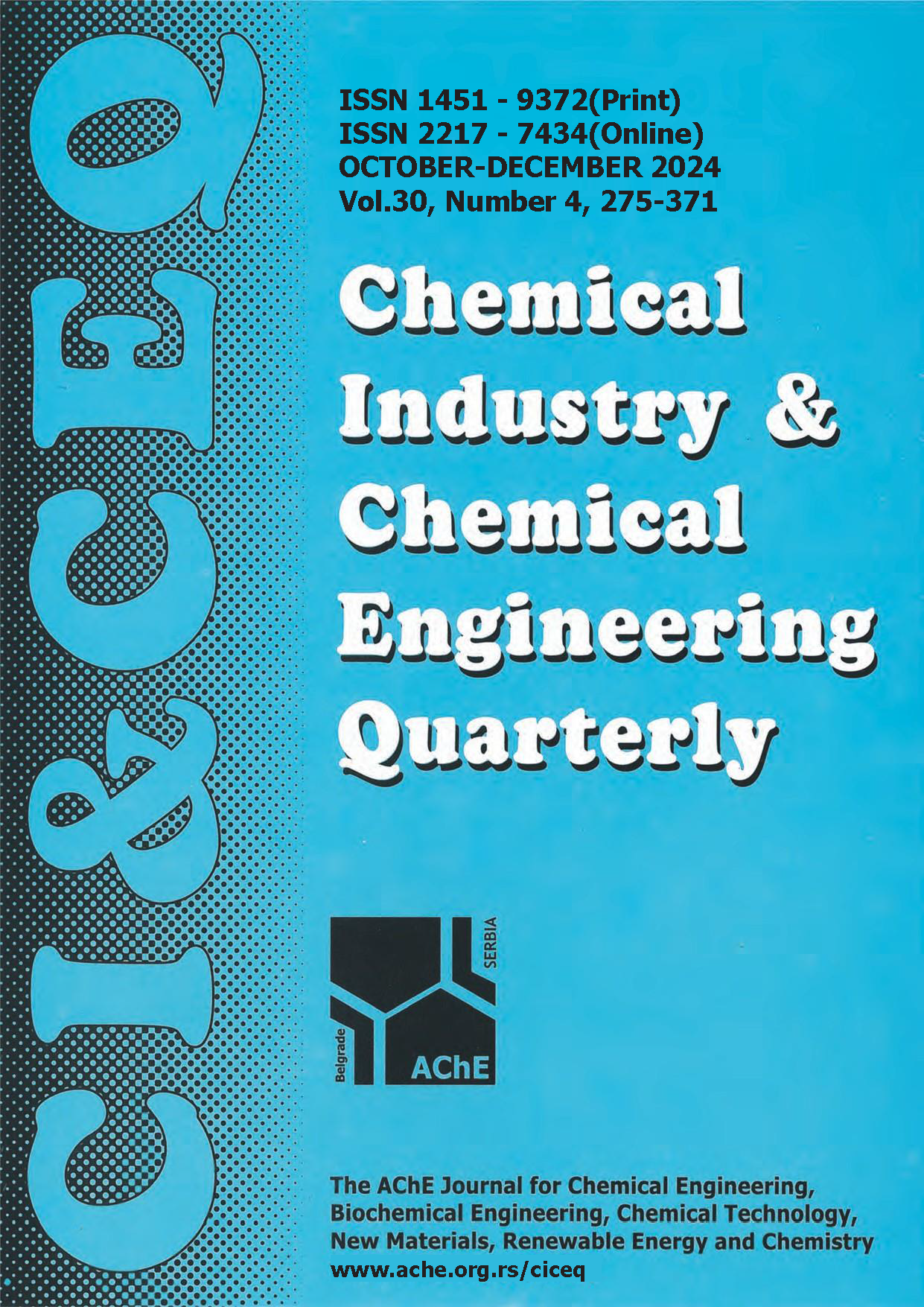THE MAGNETOHYDRODYNAMIC WILLIAMSON FLUID FLOW ON AN EXTENDING SHEET WITH THERMOPHORESIS AND CHEMICAL REACTION
Original scientific paper
DOI:
https://doi.org/10.2298/CICEQ230928005NKeywords:
Williamson fluid, magnetohydrodynamics, chemical reaction, thermophoresisAbstract
This research investigates the steady, two-dimensional, incompressible flow of a pseudoplastic Williamson fluid subjected to a linearly stretched sheet. The study incorporates the effects of magnetic fields, chemical reactions, and thermophoresis on fluid behavior. By applying boundary layer techniques and similarity transformations, the governing equations are simplified for numerical analysis. The MATLAB bvp4c solver is employed to solve the reduced equations. The obtained results are visually represented and thoroughly discussed to comprehend the model's physical characteristics. The investigation highlights the magnetic field's influence, chemical reaction, and impact of thermophoresis particle deposition on the flow behavior of Williamson fluid over the extended sheet. Moreover, significant roles are found for chemical reactions and thermophoresis parameters in determining the fluid concentration near the boundary layer. It is observed that an increase in the chemical reactions and thermophoresis parameters results in a reduced thickness of the fluid concentration near the boundary layer. Notably, an increase in Schmidt value also diminished the thickness of the fluid concentration close to the boundary layer. The magnetohydrodynamic parameter significantly influences the fluid's velocity and temperature near the surface. It has been noted that an increase in the magnetohydrodynamic parameter decreases the fluid’s velocity and increases the temperature near the surface. The impact of skin friction coefficient and Nusselt number and the impact of mass transfer coefficient on Williamson fluid will be discussed. The findings acquired are examined in relation to existing research and the correlation is provided as a table.
References
R.V. Williamson, Ind. Eng. Chem. Res. 21(1929) 1108—1111. https://doi.org/10.1021/ie50239a035.
B.C. Sakiadis, AIChe J. 7 (1961) 26—28. https://doi.org/10.1002/aic.690070108.
F.K. Tsou, E.M. Sparrow, R.J. Goldstein, Int. J. Heat Mass Transfer 10 (1967) 219—235. https://doi.org/10.1016/0017-9310(67)90100-7.
L.E. Erickson, L.T. Fan., V.G. Fox, Ind. Eng. Chem. 5 (1966) 19—25. https://doi.org/10.1021/i160017a004.
S. Nadeem, S.T. Hussain, C. LeeBraz. J. Chem. Eng. 30(3) (2013) 619—625. https://doi.org/10.1590/S0104-66322013000300019.
T. Hayat, A. Shafiq, A. Alsaedi, Alexandria Eng. J. 55(3) (2016) 2229—2240. https://doi.org/10.1016/j.aej.2016.06.004.
H.M. Shawky, N.T. Eldabe, K.A. Kamel, E.A. Abd-Aziz, Microsyst. Technol. 25(4) (2018) 1155—1169. https://doi.org/10.1007/s00542-018-4081-1.
S. Nadeem, S.T. Hussain, Appl. Nanosci. 4(8) (2014) 1005—1012. https://doi.org/10.1007/s13204-013-0282-1.
S. Nadeem, S.T. Hussain, J. Appl. Fluid Mech. 9 (2) (2016) 729—739. https://doi.org/10.18869/acadpub.jafm.68.225.21487.
T. Kebede, E. Haile, G. Awgichew, T. Waleign, J. Appl. Math. 2020 (2020) 1—13. https://doi.org/10.1155/2020/1890972.
I.C. Liu, Int. Commun. Heat Mass Transfer 32 (8) (2005) 1075—1084. https://doi.org/10.1016/j.icheatmasstransfer.2005.02.003.
M.A.A. Hammad, M. Ferdows, Appl. Math. Mech. 33 (7) (2012) 923—930. https://doi.org/10.1007/s10483-012-1595-7.
F.M. Ali, R. Nazar, N.M. Arifin, I. Pop, Appl. Math. Mech. 32 (4) (2011) 409—418. https://doi.org/10.1007/s10483-011-1426-6.
V. Kumaran, G. Ramanaiah, Acta Mech. 116 (1—4) (1996) 229—233. https://doi.org/10.1007/BF01171433.
M.E. Ali, Int. J. Heat Mass Transfer 16 (1995) 280—290. https://doi.org/10.1016/0142-727X(95)00001-7.
E.M.A. Elbashbeshy, Arch. Mech. 53 (6) (2001) 643—651. https://am.ippt.pan.pl/am/article/viewFile/v53p643/pdf.
E. Sanjayanand, S.K. Khan, Int. J. Therm. Sci. 45 (2006) 819—828. https://doi.org/10.1016/j.ijthermalsci.2005.11.002.
E. Magyari, B. Keller, J. Phys. D: Appl. Phys. 32 (1999) 577—585. http://doi.org/10.1007/s002310000126.
S. Nadeem, S. Zaheer, T. Fang, Numer. Algorithms 57 (2011) 187—205. http://dx.doi.org/10.1007/s11075-010-9423-8.
E.Sanjayanand, S. K. Khan, Intl. J. Therm. Sci. 45, (2006) 819—828. https://doi.org/10.1016/j.ijthermalsci.2005.11.002.
E. Magyari, and B. Keller, J. Physics D: Appl. Physics, 32, (1999) 577—585. http://dx.doi.org/10.1088/0022-3727/32/5/012.
S. Nadeem, S. Zaheer, T. Fang, Numer. Algorithms 57, (2011) 187—205. http://dx.doi.org/10.1007/s11075-010-9423-8.
S. Nadeem, C. Lee, Nanoscale Res. Lett. 7, (2012) 94 https://doi.org/10.1186/1556-276X-7-94.
M.S. Arif, K. Abodayeh, Y. Nawaz, Axioms,12(5), (2023) 460, https://doi.org/10.3390/axioms12050460.
Y. Nawaz, M.S. Arif, K. Abodayeh, Int. J. Numer. Methods Fluids, 94 (7), (2022) 920—940. https://doi.org/10.1002/fld.5078.
P. Loganathan, N.G. Stepha, J. Appl. Fluid Mech, 6(4), (2013) 581—588. 10.36884/JAFM.6.04.21276.
M. Ismail, D.M. Gururaj, Heat Transf. 50(4) (2021), 4019—4038 https://doi.org/10.1002/htj.22062.
M. Ismail, D.M. Gururaj, J. Nanofluids, 12 (3), (2023), 809—818. https://doi.org/10.1166/jon.2023.1962.
M. Ismail, D.M. Gururaj, Numer. Heat Transf. B: Fundam. (2023) 1—27. https://doi.org/10.1080/10407790.2023.2257381.
P. Loganathan, N. Golden Stepha, Asia Pac. J. Chem. Eng. 8(6) (2013), 870—879 https://doi.org/10.1002/apj.1732.
L.E. Erickson, L.T Fan, V.G. Fox, Ind. Eng. Chem. Fundam. 5(1), (1966), 19—25. https://doi.org/10.1021/i160017a004.
V.K. Garg, S. Jayaraj. Int. J. Heat Mass Transfer, 31 (1998) 875—890. https://doi.org/10.1016/0017-9310(88)90144-5.
N.A. Khan, H. Khan, Nonlinear Eng. 3(2), (2014)107—115. https://doi.org/10.1515/nleng-2014-0002.
H. Maaitah, A.N. Olimat, O. Quran, H.M. Duwairi, Int. J. Thermofluids, 19 (2023) 100361. https://doi.org/10.1016/j.ijft.2023.100361.
A.M. Megahed, IJMPC, 31(1), (2020) 2050019. http://doi.org/10.1142/S0129183120500199.
Downloads
Published
Issue
Section
License
Copyright (c) 2023 Golden Stepha Nallathambi, Bharathi Gowri Sasi Kumar, Guvva Swathy

This work is licensed under a Creative Commons Attribution-NonCommercial-NoDerivatives 4.0 International License.
Authors who publish with this journal agree to the following terms:
Authors retain copyright and grant the journal right of first publication with the work simultaneously licensed under a Creative Commons Attribution License that allows others to share the work with an acknowledgement of the work's authorship and initial publication in this journal.
Authors grant to the Publisher the following rights to the manuscript, including any supplemental material, and any parts, extracts or elements thereof:
- the right to reproduce and distribute the Manuscript in printed form, including print-on-demand;
- the right to produce prepublications, reprints, and special editions of the Manuscript;
- the right to translate the Manuscript into other languages;
- the right to reproduce the Manuscript using photomechanical or similar means including, but not limited to photocopy, and the right to distribute these reproductions;
- the right to reproduce and distribute the Manuscript electronically or optically on any and all data carriers or storage media – especially in machine readable/digitalized form on data carriers such as hard drive, CD-Rom, DVD, Blu-ray Disc (BD), Mini-Disk, data tape – and the right to reproduce and distribute the Article via these data carriers;
- the right to store the Manuscript in databases, including online databases, and the right of transmission of the Manuscript in all technical systems and modes;
- the right to make the Manuscript available to the public or to closed user groups on individual demand, for use on monitors or other readers (including e-books), and in printable form for the user, either via the internet, other online services, or via internal or external networks.






